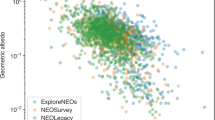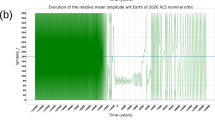Abstract
IN 1947, Whipple1 published new elements of the Geminid meteor shower, obtained photographically. An extremely short period, 1.65 years, moderate inclination and considerable eccentricity (see below) together make the orbit of this shower an extraordinary one both in comparison with comets and with minor planets. But, according to Hoffmeister2, the existence of similar meteor showers seems to be indicated. Such a short-period meteor shower as the Geminids presents new aspects in meteor astronomy. Planetary perturbations are likely to play a great part in its nature. The study of secular perturbations is especially important, both in investigating the connexion with comets, and also from the observer's point of view; for example, Adams's classical work on the Leonids.
This is a preview of subscription content, access via your institution
Access options
Subscribe to this journal
Receive 51 print issues and online access
$199.00 per year
only $3.90 per issue
Buy this article
- Purchase on Springer Link
- Instant access to full article PDF
Prices may be subject to local taxes which are calculated during checkout
Similar content being viewed by others
References
Whipple, Proc. Amer. Phil. Soc., 91, (2), 189 (1947).
Hoffmeister, Pop. Astron., 55, 33 (1947).
Guth, “Tables …des époques”, Pub. de l'Obs. Nat. Prague, No. 12 (1939).
Malzev, Russian Astron. J., 8, 63 (1931).
Author information
Authors and Affiliations
Rights and permissions
About this article
Cite this article
PLAVEC, M. The Geminid Meteor Shower. Nature 165, 362–363 (1950). https://doi.org/10.1038/165362b0
Issue Date:
DOI: https://doi.org/10.1038/165362b0
This article is cited by
-
Meteoroid streams and the sporadic background
Earth, Moon, and Planets (1995)
Comments
By submitting a comment you agree to abide by our Terms and Community Guidelines. If you find something abusive or that does not comply with our terms or guidelines please flag it as inappropriate.



